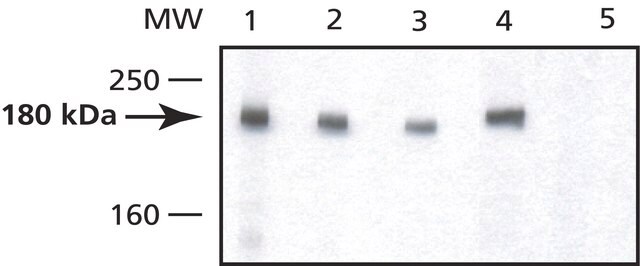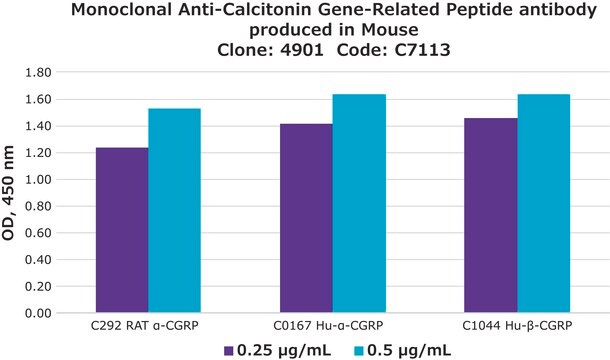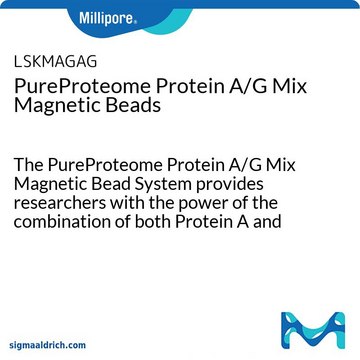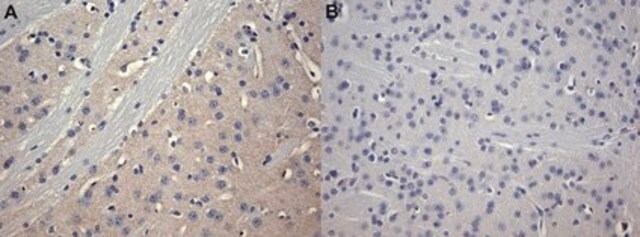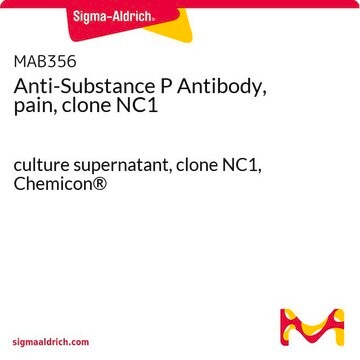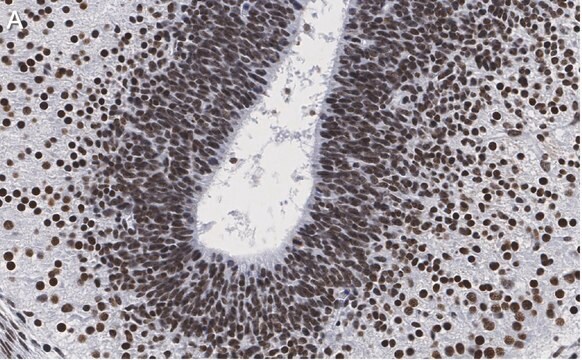MAB317
Anti-Calcitonin Gene Related Peptide Antibody, α hCGRP a.a. 28-37, clone CD8
clone CD8, Chemicon®, from mouse
Sign Into View Organizational & Contract Pricing
All Photos(1)
About This Item
UNSPSC Code:
12352203
eCl@ss:
32160702
NACRES:
NA.41
Recommended Products
biological source
mouse
Quality Level
antibody form
purified antibody
antibody product type
primary antibodies
clone
CD8, monoclonal
species reactivity
guinea pig, human
should not react with
rat
manufacturer/tradename
Chemicon®
technique(s)
ELISA: suitable
immunohistochemistry: suitable
isotype
IgG1
NCBI accession no.
UniProt accession no.
shipped in
wet ice
target post-translational modification
unmodified
Gene Information
human ... CALCA(796)
Specificity
Highly specific for CGRP and does not cross-react with other amino acids.
Immunogen
A terminal fragment of hCGRP coupled to BSA with glutaraldehyde.
Epitope: alpha hCGRP a.a. 28-37
Application
Anti-Calcitonin Gene Related Peptide Antibody, α hCGRP a.a. 28-37, clone CD8 is an antibody against Calcitonin Gene Related Peptide for use in ELISA, IH.
Immunohistochemistry at 1:200-1:400. Antibody not reactive on formalin fixed tissues. 4% PFA frozen tissues preferred. Immersion (2 hours) or perfused (pH7.4); Blocking in PBS with 3% BSA or NGS containing 0.1% triton X-100 is advised. Primary antibody should be diluted only in PBS with no detergent or blocking compounds.
ELISA: against BSA-conjugated alpha CGRP peptide.
Optimal working dilutions to be determined by end user.
ELISA: against BSA-conjugated alpha CGRP peptide.
Optimal working dilutions to be determined by end user.
Research Category
Neuroscience
Neuroscience
Research Sub Category
Hormones & Receptors
Hormones & Receptors
Physical form
Format: Purified
Storage and Stability
Maintain refrigerated at 2-8°C for up to 12 months.
Legal Information
CHEMICON is a registered trademark of Merck KGaA, Darmstadt, Germany
Disclaimer
Unless otherwise stated in our catalog or other company documentation accompanying the product(s), our products are intended for research use only and are not to be used for any other purpose, which includes but is not limited to, unauthorized commercial uses, in vitro diagnostic uses, ex vivo or in vivo therapeutic uses or any type of consumption or application to humans or animals.
Not finding the right product?
Try our Product Selector Tool.
recommended
Product No.
Description
Pricing
Storage Class
12 - Non Combustible Liquids
wgk_germany
WGK 2
flash_point_f
Not applicable
flash_point_c
Not applicable
Certificates of Analysis (COA)
Search for Certificates of Analysis (COA) by entering the products Lot/Batch Number. Lot and Batch Numbers can be found on a product’s label following the words ‘Lot’ or ‘Batch’.
Already Own This Product?
Find documentation for the products that you have recently purchased in the Document Library.
Inhibition of tumour necrosis factor and IL-17 production by leflunomide involves the JAK/STAT pathway.
I Gonzalez-Alvaro,A M Ortiz,C Dominguez-Jimenez,A Aragon-Bodi,B Diaz Sanchez,F Sanchez-Madrid
Annals of the Rheumatic Diseases null
Katarzyna Palus et al.
International journal of molecular sciences, 21(1) (2019-12-22)
The digestive tract, especially the small intestine, is one of the main routes of acrylamide absorption and is therefore highly exposed to the toxic effect of acrylamide contained in food. The aim of this experiment was to elucidate the effect
E Szabat et al.
The Histochemical journal, 26(4), 317-326 (1994-04-01)
A monoclonal antibody (mAb), 129CD8 was raised against a C-terminal fragment (aa28-37) of alpha-human calcitonin gene-related peptide (CGRP) coupled to bovine serum albumin. The specificity of the monoclonal antibody 129CD8 was corroborated by dot immunobinding experiments, enzyme-linked immunoassay and immunostaining
Sally I Firth et al.
Experimental eye research, 75(1), 49-60 (2002-07-19)
The neuropeptide galanin has not been localized previously in the primate uvea, and the neuropeptide somatostatin has not been localized in the uvea of any mammal. Here, the distribution of galanin-like and somatostatin-like immunoreactive axons in the iris, ciliary body
Do-Hee Kim et al.
Scientific reports, 7(1), 15214-15214 (2017-11-11)
Acupuncture, a traditional medical procedure practised for over 2000 years in Asia, stimulates specific but poorly defined sites called acupoints. To date, no unique anatomical acupoint structures have been found. However, noxious sensory signals from visceral organs produce hypersensitive spots
Our team of scientists has experience in all areas of research including Life Science, Material Science, Chemical Synthesis, Chromatography, Analytical and many others.
Contact Technical Service